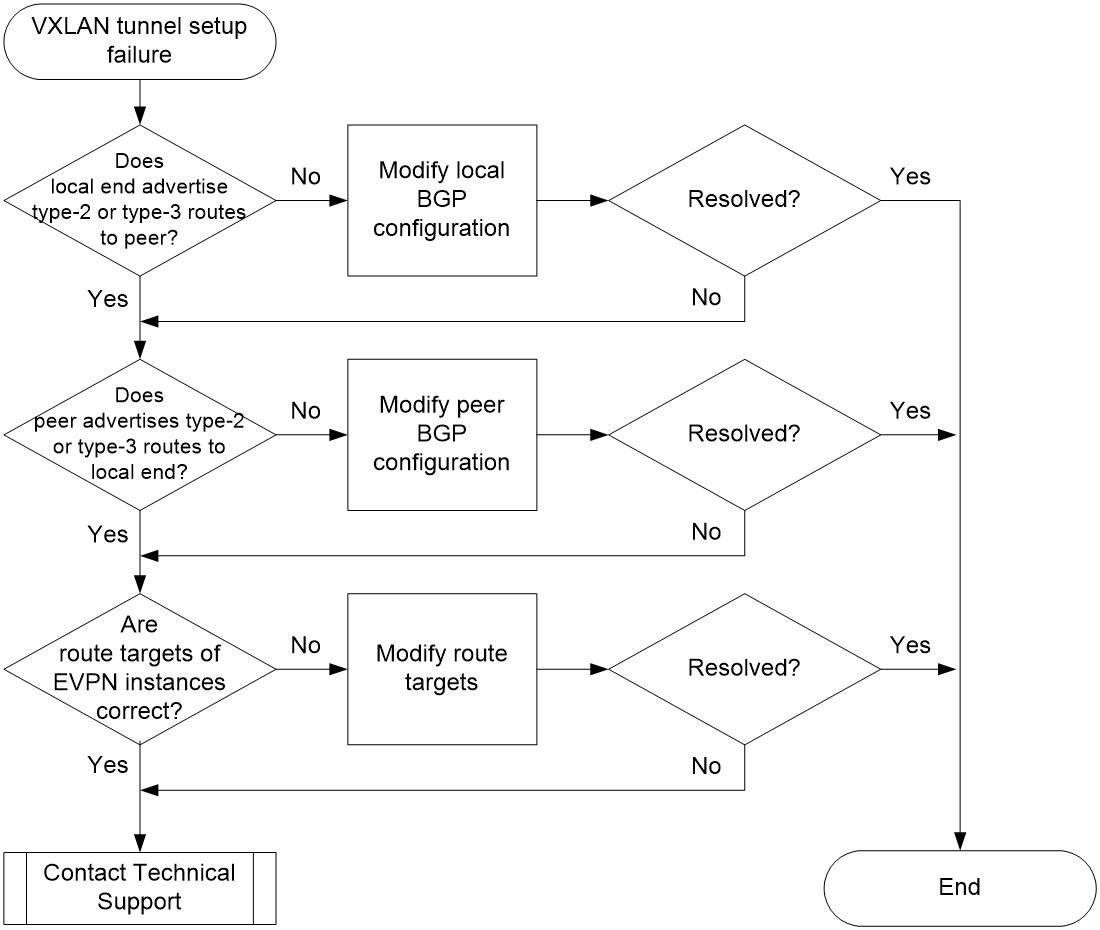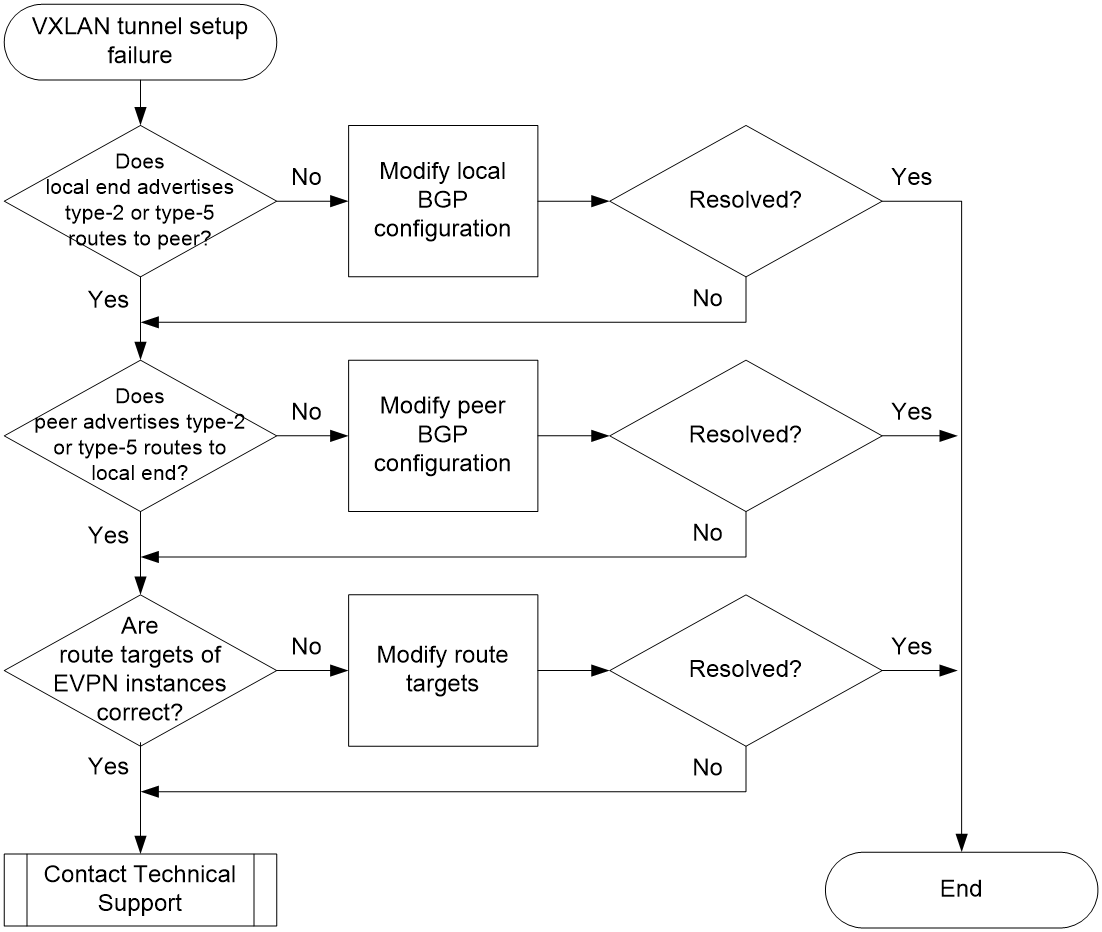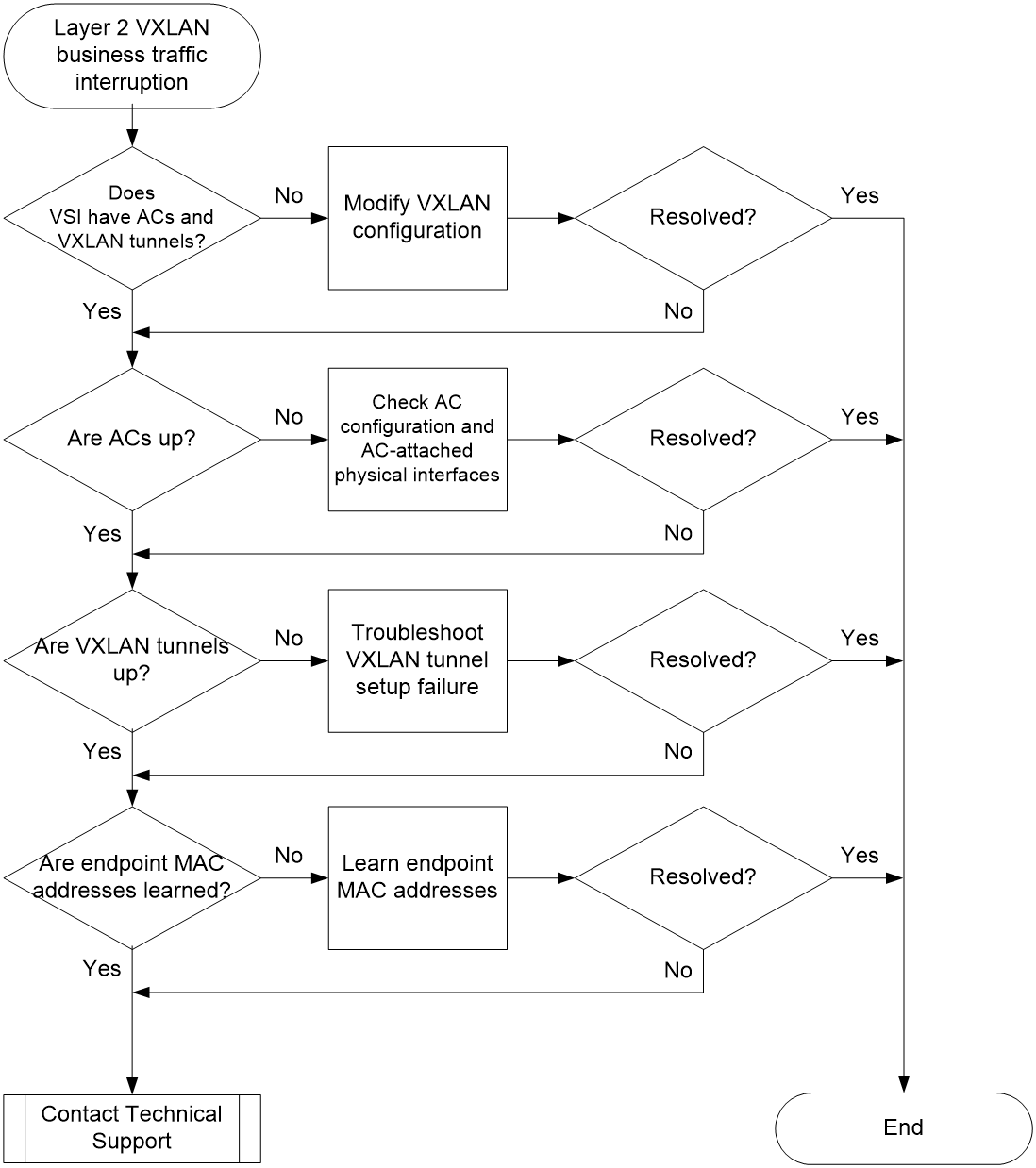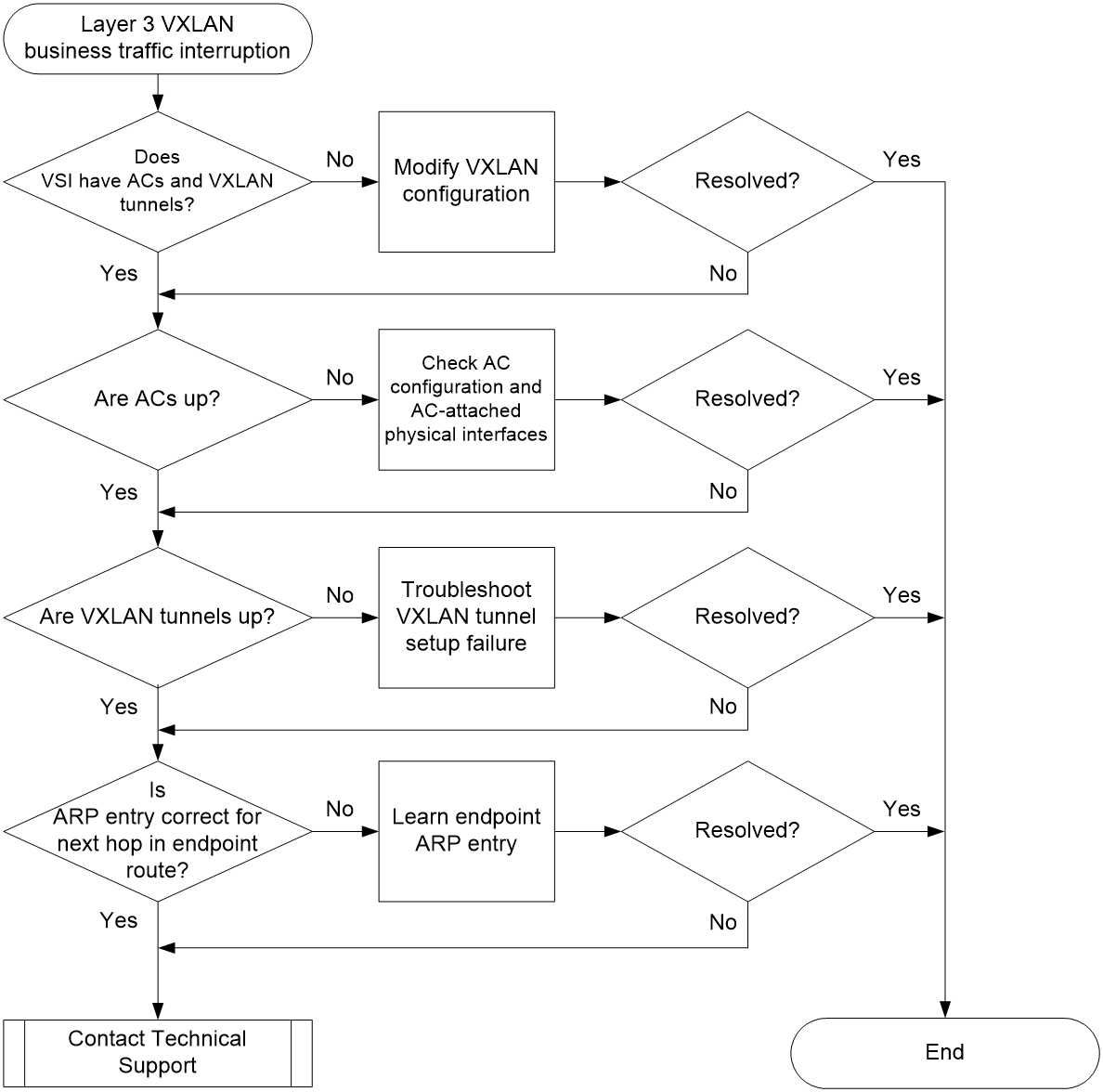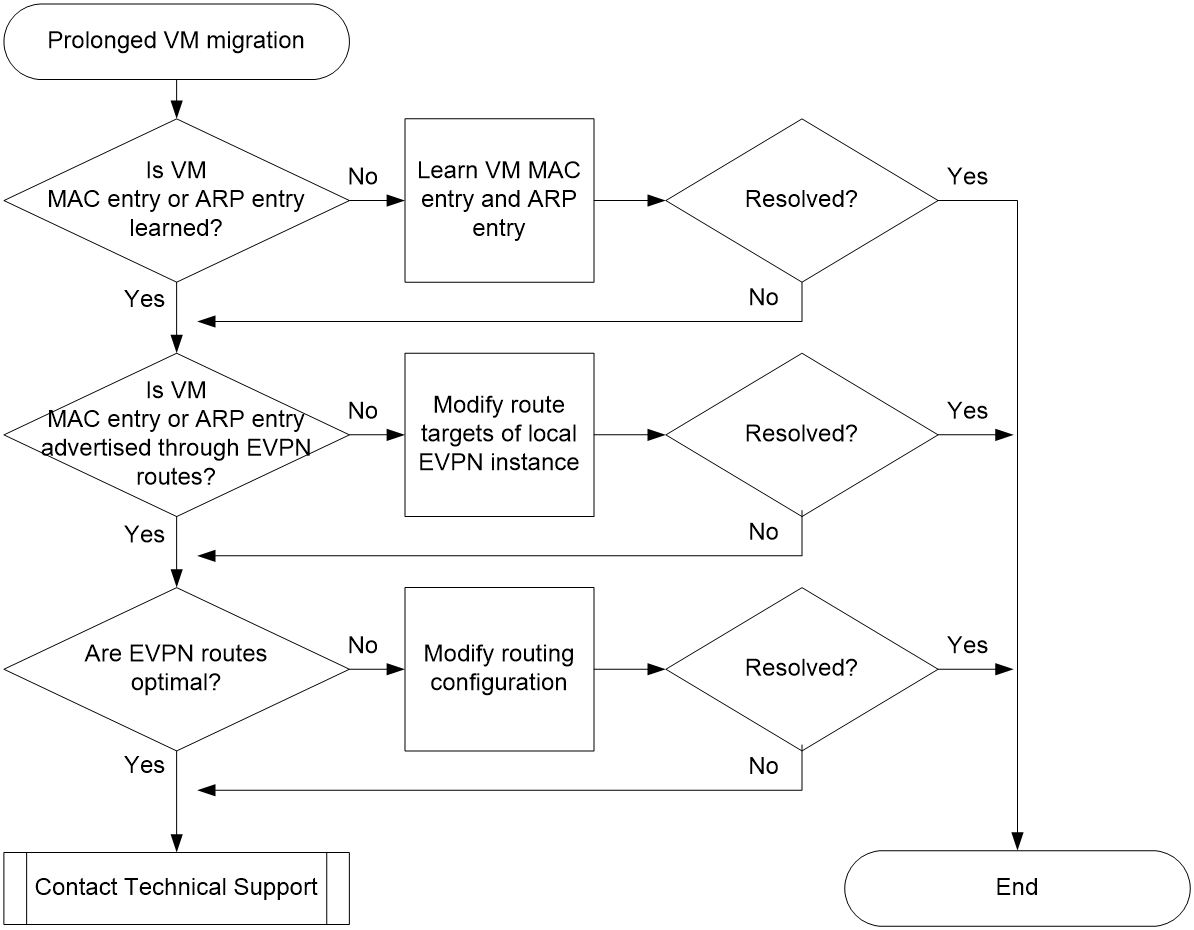- Table of Contents
- Related Documents
-
| Title | Size | Download |
|---|---|---|
| 01-EVPN VXLAN Troubleshooting Guide | 133.29 KB |
Troubleshooting EVPN
Troubleshooting EVPN VXLAN
Intra-VXLAN tunnel setup failure in an EVPN VXLAN network with distributed gateways
Symptom
In an EVPN network with distributed gateways, tunnels cannot be established between VTEPs in the same VXLAN.
Common causes
The following are the common causes of this type of issue:
· Type-2 EVPN routes (MAC/IP advertisement routes) and type-3 EVPN routes (IMET routes) have not been received.
· The RT configuration is incorrect on EVPN instances.
Troubleshooting flow
Troubleshoot the issue by using the following process:
1. Verify that type-2 routes have been received.
2. Verify that type-3 routes have been received.
3. Verify that the RT configuration for EVPN instances is correct.
Figure 1 shows the troubleshooting process.
Figure 1 Flowchart for troubleshooting intra-VXLAN tunnel setup failure
Solution
To resolve the issue:
1. Execute the display bgp l2vpn evpn command on the local end to check if the local end has advertised type-2 or type-3 routes to the peer end. For example, the following output indicates that the local end has advertised type-2 and type-3 routes to 4.4.4.4. If a Route Reflector (RR) exists in the network, specify the RR address when you execute the display bgp l2vpn evpn command. If not, specify the peer end's address.
<Sysname> display bgp l2vpn evpn peer 4.4.4.4 advertised-routes
Total number of routes: 2
BGP local router ID is 1.1.1.1
Status codes: * - valid, > - best, d - dampened, h - history,
s - suppressed, S - stale, i - internal, e - external,
a - additional-path
Origin: i - IGP, e - EGP, ? - incomplete
Route distinguisher: 2:2
Total number of routes: 2
Network NextHop MED LocPrf Path/Ogn
* > [2][0][48][0e86-19b6-0308][0][0.0.0.0]/104
0.0.0.0 0 100 i
* > [3][0][32][1.1.1.1]/80
0.0.0.0 0 100 i
¡ If the local end has advertised type-2 or type-3 routes to the peer end, go to step 2.
¡ If the local end has not advertised type-2 and type-3 routes to the peer end, check if BGP is configured correctly for EVPN. For more information, see EVPN VXLAN configuration in EVPN Configuration Guide.
2. Execute the display bgp l2vpn evpn command on the peer end to check if the peer end has advertised type-2 or type-3 routes to the local end. For example, the following output indicates that the peer end has advertised type-2 and type-3 routes to 4.4.4.4. If an RR exists in the network, specify the RR address when you execute the display bgp l2vpn evpn command. If not, specify the peer end's address.
<Sysname> display bgp l2vpn evpn peer 4.4.4.4 advertised-routes
Total number of routes: 2
BGP local router ID is 3.3.3.3
Status codes: * - valid, > - best, d - dampened, h - history,
s - suppressed, S - stale, i - internal, e - external,
a - additional-path
Origin: i - IGP, e - EGP, ? - incomplete
Route distinguisher: 1:1
Total number of routes: 2
Network NextHop MED LocPrf Path/Ogn
* > [2][0][48][0e86-23cf-0507][0][0.0.0.0]/104
0.0.0.0 0 100 i
* > [3][0][32][3.3.3.3]/80
0.0.0.0 0 100 i
¡ If the peer end has advertised type-2 or type-3 routes to the local end, go to step 3.
¡ If the peer end has not advertised type-2 and type-3 routes to the local end, check if BGP is configured correctly for EVPN. For more information, see EVPN VXLAN configuration in EVPN Configuration Guide.
3. Execute the display this command in VSI view to check if export targets and import targets on both ends are correct.
[Sysname-vsi-aaa] display this
#
vsi aaa
vxlan 10
evpn encapsulation vxlan
route-distinguisher 2:2
vpn-target 1:1 export-extcommunity
vpn-target 2:2 import-extcommunity
#
return
¡ If the route targets are inconsistent on the local and peer ends, execute the vpn-target command in VSI view to modify the incorrect route targets.
¡ If the route targets are consistent on the local peer and ends, go to step 4.
4. If the issue persists, collect the following information and contact Technical Support:
¡ Results of each step.
¡ The configuration file, log messages, and alarm messages.
¡ Diagnostic information collected by using the display diagnostic-information command.
Related alarm and log messages
Alarm messages
None.
Log messages
None.
Inter-VXLAN tunnel setup failure in an EVPN VXLAN network with distributed gateways
Symptom
In an EVPN network with distributed gateways, tunnels cannot be established between VTEPs in different VXLANs.
Common causes
The following are the common causes of this type of issue:
· Type-2 EVPN routes and type-5 EVPN routes (IP prefix advertisement routes) have not been received.
· The RT configuration is incorrect on VPN instances.
Troubleshooting flow
Troubleshoot the issue by using the following process:
1. Verify that type-2 routes have been received.
2. Verify that type-5 routes have been received.
3. Verify that the RT configuration for VPN instances is correct.
Figure 2 shows the troubleshooting process.
Figure 2 Flowchart for troubleshooting inter-VXLAN tunnel setup failure
Solution
To resolve the issue:
1. Execute the display bgp l2vpn evpn command on the local end to check if the local end has advertised type-2 or type-5 routes to the peer end. For example, the following output indicates that the local end has advertised type-2 and type-5 routes to 4.4.4.4. If an RR exists in the network, specify the RR address when you execute the display bgp l2vpn evpn command. If not, specify the peer end's address.
<Sysname> display bgp l2vpn evpn peer 4.4.4.4 advertised-routes
Total number of routes: 3
BGP local router ID is 1.1.1.1
Status codes: * - valid, > - best, d - dampened, h - history,
s - suppressed, S - stale, i - internal, e - external,
a - additional-path
Origin: i - IGP, e - EGP, ? - incomplete
Route distinguisher: 1:1
Total number of routes: 1
Network NextHop MED LocPrf Path/Ogn
* > [5][0][24][10.1.1.0]/80
0.0.0.0 0 100 i
Route distinguisher: 2:2
Total number of routes: 2
Network NextHop MED LocPrf Path/Ogn
* > [2][0][48][0e86-19b6-0308][0][0.0.0.0]/104
0.0.0.0 0 100 i
* > [3][0][32][1.1.1.1]/80
0.0.0.0 0 100 i
¡ If the local end has advertised type-2 or type-5 routes to the peer end, go to step 2.
¡ If the local end has not advertised type-2 and type-5 routes to the peer end, check if BGP is configured correctly for EVPN. For more information, see EVPN VXLAN configuration in EVPN Configuration Guide.
2. Execute the display bgp l2vpn evpn command on the peer end to check if the peer end has advertised type-2 or type-5 routes to the local end. For example, the following output indicates that the peer end has advertised type-2 and type-5 routes to 4.4.4.4. If an RR exists in the network, specify the RR address when you execute the display bgp l2vpn evpn command. If not, specify the peer end's address.
<Sysname> display bgp l2vpn evpn peer 4.4.4.4 advertised-routes
Total number of routes: 3
BGP local router ID is 3.3.3.3
Status codes: * - valid, > - best, d - dampened, h - history,
s - suppressed, S - stale, i - internal, e - external,
a - additional-path
Origin: i - IGP, e - EGP, ? - incomplete
Route distinguisher: 1:1
Total number of routes: 2
Network NextHop MED LocPrf Path/Ogn
* > [2][0][48][0e86-23cf-0507][0][0.0.0.0]/104
0.0.0.0 0 100 i
* > [3][0][32][3.3.3.3]/80
0.0.0.0 0 100 i
Route distinguisher: 3:3
Total number of routes: 2
Network NextHop MED LocPrf Path/Ogn
* > [5][0][24][10.1.1.0]/80
0.0.0.0 0 100 i
¡ If the peer end has advertised type-2 or type-5 routes to the local end, go to step 3.
¡ If the peer end has not advertised type-2 and type-5 routes to the local end, check if BGP is configured correctly for EVPN. For more information, see EVPN VXLAN configuration in EVPN Configuration Guide.
3. Execute the display this command in L3VNI VPN instance view to check if export targets and import targets on both ends are correct.
[Sysname-vpn-instance-vpna] display this
#
ip vpn-instance vpna
route-distinguisher 1:1
#
address-family evpn
vpn-target 1:1 import-extcommunity
vpn-target 1:1 export-extcommunity
#
return
¡ If the route targets are inconsistent on the local and peer ends, execute the vpn-target command to modify the incorrect route targets.
¡ If the route targets are consistent on the local peer and ends, go to step 4.
4. If the issue persists, collect the following information and contact Technical Support:
¡ Results of each step.
¡ The configuration file, log messages, and alarm messages.
¡ Diagnostic information collected by using the display diagnostic-information command.
Related alarm and log messages
Alarm messages
None.
Log messages
None.
Layer 2 VXLAN business traffic interruption
Symptom
A VXLAN network cannot forward Layer 2 VXLAN business traffic.
Common causes
The following are the common causes of this type of issue:
· ACs or VXLAN tunnels are not established.
· MAC addresses are not learned.
Troubleshooting flow
Figure 3 shows the troubleshooting flowchart.
Figure 3 Flowchart for troubleshooting Layer 2 VXLAN business traffic interruption
Solution
To resolve the issue:
1. Execute the display l2vpn vsi verbose command to view the VXLAN tunnels and ACs of the involved VSI.
<Sysname> display l2vpn vsi verbose
VSI Name: vpna
VSI Index : 0
VSI State : Up
MTU : 1500
Bandwidth : Unlimited
Broadcast Restrain : Unlimited
Multicast Restrain : Unlimited
Unknown Unicast Restrain: Unlimited
MAC Learning : Enabled
MAC Table Limit : -
MAC Learning rate : -
Drop Unknown : -
Flooding : Enabled
Statistics : Disabled
VXLAN ID : 10
Tunnels:
Tunnel Name Link ID State Type Flood proxy
Tunnel1 0x5000001 Up Manual Disabled
ACs:
AC Link ID State Type
GE0/0/1 srv1000 0 Up Manual
¡ If both the ACs and VXLAN tunnels are up, go to step 2.
¡ If an AC is down, modify the incorrect AC configuration.
¡ If a VXLAN tunnel is down, troubleshoot the issue as described in "Intra-VXLAN tunnel setup failure in an EVPN VXLAN network with distributed gateways."
2. Execute the display l2vpn mac-address command to check the VSI MAC address table for the MAC addresses of endpoints in the network and the total number of learned MAC address entries.
<Sysname> display l2vpn mac-address
* - The output interface is issued to another VSI
MAC Address State VSI Name Link ID/Name Aging
0001-0001-0001 Static aaa Tunnel1 NotAging
52f6-bc1e-0d06 Dynamic vpna GE0/0/1 Aging
--- 3 mac address(es) found ---
¡ After you collect the preceding information, proceed with step 3.
3. If the issue persists, collect the following information and contact Technical Support:
¡ Results of each step.
¡ The configuration file, log messages, and alarm messages.
¡ Diagnostic information collected by using the display diagnostic-information command.
Related alarm and log messages
Alarm messages
None.
Log messages
None.
Layer 3 VXLAN business traffic interruption
Symptom
A VXLAN network cannot forward Layer 3 VXLAN business traffic.
Common causes
The following are the common causes of this type of issue:
· ACs or VXLAN tunnels are not established.
· The device's router MAC address is incorrect.
Troubleshooting flow
Figure 4 shows the troubleshooting flowchart.
Figure 4 Flowchart for troubleshooting Layer 3 VXLAN business traffic interruption
Solution
To resolve the issue:
1. Execute the display l2vpn vsi verbose command to view the VXLAN tunnels and ACs of the involved VSI.
<Sysname> display l2vpn vsi verbose
VSI Name: vpna
VSI Index : 0
VSI State : Up
MTU : 1500
Bandwidth : Unlimited
Broadcast Restrain : Unlimited
Multicast Restrain : Unlimited
Unknown Unicast Restrain: Unlimited
MAC Learning : Enabled
MAC Table Limit : -
MAC Learning rate : -
Drop Unknown : -
Flooding : Enabled
Statistics : Disabled
VXLAN ID : 10
Tunnels:
Tunnel Name Link ID State Type Flood proxy
Tunnel1 0x5000001 Up Manual Disabled
ACs:
AC Link ID State Type
GE0/0/1 srv1000 0 Up Manual
¡ If both the ACs and VXLAN tunnels are up, go to step 2.
¡ If an AC is down, modify the incorrect AC configuration.
¡ If a VXLAN tunnel is down, troubleshoot the issue as described in "Inter-VXLAN tunnel setup failure in an EVPN VXLAN network with distributed gateways."
2. Execute the display evpn routing-table command, check the routing table of the L3VNI VPN instance, and record the nexthop address (Nexthop field) in the route for the target endpoint IP address (IP address field).
<Sysname> display evpn routing-table vpn-instance vpn1
Flags: E - with valid ESI A – A-D ready L - Local ES exists
VPN instance name: vpn1 Local L3VNI: 7
IP address Nexthop Outgoing interface NibID Flags
10.1.1.11 1.1.1.1 Vsi-interface3 0x18000000 EAL
3. Execute the display arp command to view the ARP information for the next hop.
<Sysname> display arp
Type: S-Static D-Dynamic O-Openflow R-Rule M-Multiport I-Invalid
IP address MAC address VLAN/VSI name Interface Aging Type
1.1.1.1 00e0-fe50-6503 vsi1 Tunnel1 960 D
¡ If the nexthop address is mapped to the router MAC address, go to step 4. Execute the display interface vsi-interface command to view the MAC address of the L3VNI VSI interface, which is also the router MAC address.
¡ If the nexthop address is not mapped to the router MAC address, restore consistency between the mapped MAC address and the MAC address of the L3VNI VSI interface. Alternatively, use the evpn global-mac command to configure an EVPN global MAC address.
4. If the issue persists, collect the following information and contact Technical Support:
¡ Results of each step.
¡ The configuration file, log messages, and alarm messages.
¡ Diagnostic information collected by using the display diagnostic-information command.
Related alarm and log messages
Alarm messages
None.
Log messages
None.
Prolonged VM migration
Symptom
In an EVPN network, a VTEP does not learn the MAC address or ARP information of a VM immediately after the VM migrates to the VTEP.
Common causes
The following are the common causes of this type of issue:
· The VTEP has not learned the MAC address or ARP entry for the migrated VM.
· The VTEP has not learned the MAC address or ARP entry for the migrated VM through BGP EVPN route synchronization.
· The BGP EVPN routes synchronized between VTEPs are not optimal ones.
Troubleshooting flow
Figure 5 shows the troubleshooting flowchart.
Figure 5 Flowchart for troubleshooting prolonged VM migration
Solution
1. After the migration, check for the MAC address and ARP entry on the destination VTEP.
Execute the display l2vpn mac-address command and check the VSI MAC address table for the MAC address of the migrated VM.
<Sysname> display l2vpn mac-address
* - The output interface is issued to another VSI
MAC Address State VSI Name Link ID/Name Aging
52f6-bc1e-0d06 EVPN aaa Tunnel10 NotAging
0001-0001-0001 Dynamic vpna GE0/0/1 Aging
--- 2 mac address(es) found ---
Execute the display arp command and check the VSI ARP table for the ARP entry of the migrated VM.
<Sysname> display arp
Type: S-Static D-Dynamic O-Openflow R-Rule M-Multiport I-Invalid
IP address MAC address VLAN/VSI name Interface Aging Type
10.1.1.3 0001-0001-0001 vpna GE0/0/1 960 D
1.1.1.4 00e0-fe60-5000 vsi2 Tunnel1 -- M
¡ If a MAC address or ARP entry exists for the migrated VM, go to step 2.
¡ If no MAC address or ARP entry exists for the migrated VM, the VTEP does not learn the MAC address or ARP information of the migrated VM. Bring up the VM on the VTEP for the VTEP to learn the MAC address and ARP information.
Execute the display evpn route mac command to verify that the MAC address of the migrated VM has been learned from synchronized BGP EVPN routes. The value B in the Flags field indicates that a MAC address entry is learned from BGP EVPN routes.
<Sysname> display evpn route mac
Flags: D - Dynamic B - BGP L - Local active
G - Gateway S - Static M - Mapping I - Invalid
VSI name: bbb
EVPN instance: -
MAC address Link ID/Name Flags Encap Next hop
0000-0000-000a 1 DL VXLAN -
0001-0001-0001 Tunnel1 B VXLAN 2.2.2.2
Execute the display evpn route arp command to verify that the ARP information of the migrated VM has been learned from synchronized BGP EVPN routes. The value B in the Flags field indicates that an ARP entry is learned from BGP EVPN routes.
<Sysname> display evpn route arp
Flags: D - Dynamic B - BGP L - Local active
G - Gateway S - Static M - Mapping I - Invalid
VPN instance: vpn1 Interface: Vsi-interface1
IP address MAC address Router MAC VSI index Flags
10.1.1.1 0001-0001-0001 a0ce-7e40-0400 0 B
10.1.1.11 0001-0001-0002 a0ce-7e40-0400 0 DL
10.1.1.101 0001-0011-0101 a0ce-7e40-0400 0 SL
10.1.1.102 0001-0011-0102 0011-9999-0000 0 BS
¡ If a MAC address entry or ARP entry has been learned through BGP EVPN route synchronization for the migrated VM, go to step 3.
¡ If no MAC address entry or ARP entry has been learned through BGP EVPN route synchronization for the migrated VM, execute the vpn-target command to modify the route targets of the local EVPN instance. Make sure the EVPN instance's route targets on the local and peer ends are consistent.
3. Execute the display bgp l2vpn evpn command and verify that the MAC/IP advertisement route carrying the MAC address and ARP information of the migrated VM is optimal. Verify that the values in the State field include best. In the following output, the MAC/IP advertisement route advertises MAC address 0001-0203-0405 and IP address 5.5.5.5/32, and the route state values include best.
<Sysname> display bgp l2vpn evpn route-distinguisher 1.1.1.1:100 [2][5][48][0001-0203-0405][32][5.5.5.5] 136
BGP local router ID: 172.16.250.133
Local AS number: 100
Route distinguisher: 1.1.1.1:100
Total number of routes: 1
Paths: 1 available, 1 best
BGP routing table information of [2][5][48][0001-0203-0405][32][5.5.5.5]/136:
From : 10.1.1.2 (192.168.56.17)
Rely nexthop : 10.1.1.2
Original nexthop: 10.1.1.2
OutLabel : NULL
Ext-Community : <RT: 1:2>, <RT: 1:3>, <RT: 1:4>, <RT: 1:5>, <RT: 1:6>, <RT: 1:7
>, <Encapsulation Type: VXLAN>, <Router's Mac: 0006-0708-0910
>, <MAC Mobility: Flag 0, SeqNum 2>, <Default GateWay>
RxPathID : 0x0
TxPathID : 0x0
AS-path : 200
Origin : igp
Attribute value : MED 0, pref-val 0
State : valid, external, best
IP precedence : N/A
QoS local ID : N/A
Traffic index : N/A
EVPN route type : MAC/IP advertisement route
ESI : 0001.0203.0405.0607.0809
Ethernet tag ID : 5
MAC address : 0001-0001-0001
IP address : 10.1.1.1/32
MPLS label1 : 10
MPLS label2 : 100
Re-origination : Enable
¡ If the MAC/IP advertisement route is an optimal route, go to step 4.
¡ If the MAC/IP advertisement route is an optimal route, modify routing configuration for the route to be an optimal one.
4. If the issue persists, collect the following information and contact Technical Support:
¡ Results of each step.
¡ The configuration file, log messages, and alarm messages.
¡ Diagnostic information collected by using the display diagnostic-information command.
Related alarm and log messages
Alarm messages
None.
Log messages
None.
Unavailability to access a VM after MAC migration
Symptom
After MAC address migration occurs on a VTEP, endpoints cannot access the migrated VM.
Common causes
The common causes of this issue are traffic anomalies and an incorrect outgoing interface in the MAC address entry for the VM due to network attacks.
Troubleshooting flow
Troubleshoot the issue by using the following process:
1. View the MAC address migration information.
2. Verify that the outgoing interface in the MAC address entry for the VM is correct.
Solution
1. Execute the display evpn route mac-mobility command to view the MAC address migration information. In the following output, MAC address 1000-0000-0000 has migrated from GE0/0/1 to the local VTEP.
<Sysname> display evpn route mac-mobility
Flags: S - Suppressed, N - Not suppressed
Suppression threshold: 5
Detection cycle : 180s
Suppression time : Permanent
VSI name : vsia
EVPN instance : -
MAC address Move count Moved from Flags Suppressed at
1000-0000-0000 10 GE0/0/1 S 15:30:30 2018/03/30
2. Execute the display l2vpn mac-address command to verify that the outgoing interface in the MAC address entry for the VM is correct. The Link ID/Name field displays the name of the interface or tunnel interface where a MAC address is learned.
<Sysname> display l2vpn mac-address
* - The output interface is issued to another VSI
MAC Address State VSI Name Link ID/Name Aging
1000-0000-0000 EVPN aaa Tunnel10 NotAging
52f6-bc1e-0d06 Dynamic vpna GE0/0/1 Aging
--- 2 mac address(es) found ---
¡ If the outgoing interface is correct, go to step 3.
¡ If the outgoing interface is incorrect, bring up the VM on the destination VTEP for the VTEP to learn or update its forwarding entries.
3. If the issue persists, collect the following information and contact Technical Support:
¡ Results of each step.
¡ The configuration file, log messages, and alarm messages.
¡ Diagnostic information collected by using the display diagnostic-information command.
Related alarm and log messages
Alarm messages
None.
Log messages
None.

